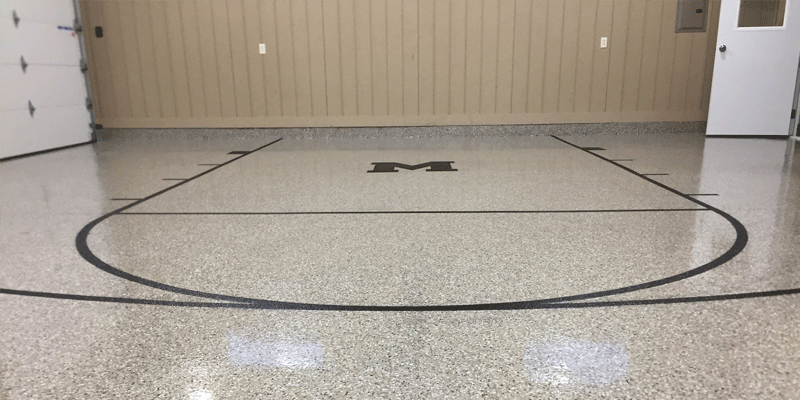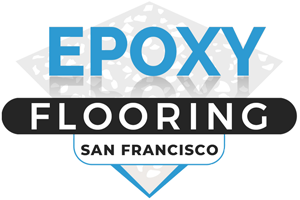Table of Contents
What You Should Know About These Floors

Are you new to epoxy and wondering what you should know about these floors before choosing one for your San Francisco home or business? Epoxy San Francisco has compiled a guide to epoxy flooring to help you learn important factors about the material, so you can make an informed decision when designing your space. If you want to learn more about epoxy and the different specifications of the material, keep reading the Epoxy Flooring 101 guide below.
Epoxy is a Versatile Flooring Material
Many home and business owners in San Francisco are surprised to learn that epoxy is one of the most versatile and durable materials used for flooring today. When compared to materials like wood or tile, epoxy provides incredible resistance against common factors like moisture, impact, and heavy foot traffic. There is also incredible versatility when choosing epoxy, as the surface appearance of the floor can be customized to your specific design preferences. There are also topcoat additives that can help transform the function and capabilities of your new floor. Standard flooring materials have benefits but lack the wide range of versatility that epoxy provides.
What Should I Know About Epoxy?
When you are first learning about epoxy, it can be overwhelming to take in all of the information and facts about the material. If you are new to this industry, all of the terms and specifics of epoxy can be confusing and can leave you wondering what is important to know about epoxy and what information is okay to skip over during research. First, it’s crucial to understand exactly what epoxy is and the specific functions that these floors can provide. Epoxy is a mixture of chemicals and hardening agents that is applied over a pre-existing material to create a strong and seamless surface. You should also know the different types of epoxy available and what variations can be added to your floor.
What You Don’t Need To Know About Epoxy
While there is endless information available about epoxy, not all of the facts are crucial for home or business owners to understand if they are just having a standard floor installed. Typically, most standard epoxy installations will not require knowledge of compressive strength ratings, tensile strength, or flexibility. These factors can be important for installations in some sensitive environments but most applications will not follow those guides. If you are looking to minimize your research time and jump right into an epoxy installation, reach out to a licensed professional like Epoxy San Francisco. Working with flooring experts ensures your epoxy installation will be flawless and provide optimal longevity.
Know the Difference Between Epoxy and Garage Paints
It’s common for clients to confuse epoxy and garage paints, but this can have dire consequences if you are choosing epoxy for its strength and durability. Epoxy is meant to be applied over concrete slabs to provide protection to the material, as well as a strong and seamless surface finish. It is a two-component system that is composed of epoxy resin and hardening chemicals. On the other hand, garage paints are water or oil-based material that can be compared to most standard paints used on walls or ceilings to change the appearance and hide imperfections. While this is good for aesthetics, garage paint will not provide protection or resistance against damaging elements and is not a good choice for sensitive environments.
Topcoats are an Important Step
In most cases, having a topcoat applied over your main epoxy layer is a crucial step of the entire installation process. There are few instances when a topcoat is not applied over an epoxy layer, as these coats are designed to add the incredible strength and shiny surface that is signature to an epoxy floor. Without a topcoat, the middle layer of an epoxy floor would become susceptible to damage from moisture, impact, hot tires, and countless other factors. This can pose difficult problems for settings like commercial businesses, damp garages, or industrial warehouses that need a floor to stand up against harsh daily functions. Choosing a topcoat to compliment your epoxy is one of the easiest ways to ensure your new floor lasts for years before needing any form of repairs or upgrades.
Be Mindful of Pot Life
Pot life is a term that many people are unfamiliar with, but it’s important to understand this when choosing an epoxy product. Generally speaking, pot life can be described as the total time an installation technician has to work with the epoxy material once all of the chemicals have been mixed. In most scenarios, epoxy will have a pot life of around one hour before the mixture starts to degrade and lose overall reliability. Pot life can be affected by factors such as weather and temperature, which is why it’s always recommended to have a professional complete any applications. Pot life can be a good indicator of the quality of your epoxy, as a longer pot life time period can be a sign of poor materials.
Reach Out to Epoxy San Francisco
If you are ready to learn more about epoxy or schedule an appointment to have your new floors installed, reach out to the team of experts at Epoxy San Francisco. The company is the number one choice among clients in the San Francisco county area and is proud to provide free consultations for both new and returning customers.
Installing epoxy can be difficult, especially if you are new to using the material or the industry itself. Epoxy is designed to be a permanent installation, which is why it’s crucial that each step of the application process is followed precisely. Don’t risk applying your epoxy alone and running into serious issues, contact Epoxy San Francisco today and receive a free no-obligation estimate on your new epoxy floors.
